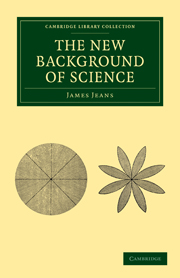Book contents
- Frontmatter
- Contents
- Preface to the First Edition
- Preface to the Second Edition
- Chapter I The Approach to the External World
- Chapter II The Methods of Science
- Chapter III The Framework of the External World—Space and Time
- Chapter IV Mechanism
- Chapter V The Texture of the External World—Matter and Radiation
- Chapter VI Wave-Mechanics
- Chapter VII Indeterminacy
- Chapter VIII Events
- Index
Chapter V - The Texture of the External World—Matter and Radiation
Published online by Cambridge University Press: 07 September 2010
- Frontmatter
- Contents
- Preface to the First Edition
- Preface to the Second Edition
- Chapter I The Approach to the External World
- Chapter II The Methods of Science
- Chapter III The Framework of the External World—Space and Time
- Chapter IV Mechanism
- Chapter V The Texture of the External World—Matter and Radiation
- Chapter VI Wave-Mechanics
- Chapter VII Indeterminacy
- Chapter VIII Events
- Index
Summary
We must now leave the vastness of astronomical space, to pass to the other extreme of the scale of size and explore the innermost recesses of the ultra-microscopic atom. While the phenomena of astronomy may shew us the nature of space and time, it is here, if anywhere, that we may hope to discover the true nature of matter and of material objects, the contents of space and time.
The Structure of Matter
We have seen how the atomic concept of matter gradually gained scientific recognition, and finally appeared to be securely established when Maxwell and others shewed that a gas could be pictured as consisting of hard bullet-like atoms or molecules flying about indiscriminately at speeds comparable with those of ordinary rifle bullets. The impact of these bullets produced the pressure of the gas; the energy of their motion was the heat-energy of the gas, so that heating up the gas resulted in its bullets travelling faster; the viscosity of a gas was caused by the drag of one bullet on another on the rare occasions on which actual collisions occurred, and so on. These concepts made it possible to explain a great number of the observed properties of gases, both qualitatively and quantitatively, with great exactness. Yet a residue obstinately defied explanation, and it is only recently that an explanation of these has been obtained, in terms of new and very different concepts to which we shall shortly pass.
- Type
- Chapter
- Information
- The New Background of Science , pp. 151 - 197Publisher: Cambridge University PressPrint publication year: 2009First published in: 1931



